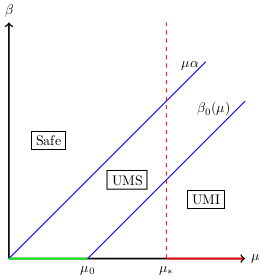A Computational Framework for Evaluating the Role of Mobility on the Propagation of Epidemics on Point Processes
This paper in collaboration with Nithin Ramesan (UT Austin, Electrical and Computer Engineering), is focused on SIS epidemic dynamics (also known as the contact process) on stationary Poisson point processes of the Euclidean plane, when the infection rate of a susceptible point is proportional to the number of infected points in a ball around it.
Two models are discussed, the first with a static point process, and the second where points are subject to some random motion.
For both models, we use conservation equations for moment measures to analyze the stationary point processes of infected and susceptible points.
A heuristic factorization of the third moment measure is then proposed to derive simple polynomial equations allowing one to derive closed form approximations for the fraction of infected nodes and the steady state.
These polynomial equations also lead to a phase diagram which tentatively delineates the regions of the space of parameters (population density, infection radius, infection and recovery rate, and motion rate) where the epidemic survives and those where there is extinction. According to this phase diagram, the survival of the epidemic is not always an increasing function of the motion rate.
These results are substantiated by simulations on large two dimensional tori. These simulations show that the polynomial equations accurately predict the fraction of infected nodes when the epidemic survives.
The phase diagram is also partly substantiated by the simulation of the mean survival time of the epidemic on large tori. The phase diagram accurately predicts the parameter regions where the mean survival time increases or decreases with the motion rate.
For more on the matter, see
- F. Baccelli, and N. Ramesan, ‘A computational framework for evaluating the role of mobility on thew
propagation of epidemics on point processes’, Journal of Mathematical Biology, volume 84, (January 2022). DOI : 10.1007/s00285-021-01692-1, URL : https://hal.science/hal-03542621
Migration-Contagion Processes
A new class of models bearing on a related class of dynamics, called migration-contagion process, was introduced in the following paper lately
- F. Baccelli, S. Foss, and S. Shneer, ‘Migration Contagion Processes’, Journal of Applied Probability, 2023. https://doi.org/10.1017/apr.2023.17.
This dynamics features a discrete migration process and a SIS dynamics in each compartment of the migration process.
Several variants of this class of dynamics have mean-field limits that can be soved in an exact way by solving partial differential equations that can be seen as wave type equations.
Galves-Löcherbach Dynamics
For the line of thoughts on the Galves-Löcherbach type dynamics for neural networks, see the Mean-Field Limit page.

